Willkommen: Hier finden Sie die deutsche Fassung des Briefes aus Berlin!Welcome to this year’s final Letter from Berlin! As the holidays begin, we focus on digital projects that can be explored online in the coming weeks as museums remain closed, at least in Germany. We hope you enjoy exploring these exciting online projects! To conclude this extraordinary year, we present a special film screening from Rosa Barba whose representation we just announced. Take a tour alongside Isa Melsheimer and Jan Kage who met last weekend in the artist's exhibition at the gallery in Berlin for a lively conversation. We present our first online exhibition with Hito Steyerl and introduce materials from K21's digital guide. Projects by Daniel Steegmann Mangrané and Jean-Pascal Flavien have real-life iterations and a strong digital presence: Steegmann Mangrané's work is currently on view in Madrid, Flavien's will be accessible in Hannover in 2021. And don’t miss the online artists’ conversation on occasion of Jeanne Tremsal’s exhibition with works by Angela Bulloch, Isa Melsheimer and Christopher Roth taking place on Saturday, December 18th. Finally, after exploring these digital exhibition projects come and visit our OVRs! We wish you festive holidays and a happy and healthy 2021!
|
|
|
Rosa Barba, Somnium, 2011— Film Screening |
|

| Rosa Barba, Somnium, 2011, 16 mm film transferred to digital video (color, sound), duration: 19:20 min
© VG Bild-Kunst, Bonn, 2020
Film still © Rosa Barba
| |
|
As the final film screening of the year, we are thrilled to feature a work by Rosa Barba whose representation the gallery announced earlier this month.
Characteristic of Rosa Barba’s evocative and often mysterious cinematic storytelling, Somnium brings together images of a frigid landscape, filmed in Maasvlakte—the massive industrial area within the Port of Rotterdam being created through land reclamation—with narrative fragments loosely focused on a beekeeper who started with his first hive on the Maasvlakte, 30 years ago, and is now surrounded by silos for oil storage. The title is taken from a fantastic story by the 17th century astronomer Johannes Kepler which introduced a book of lunar astronomy, published posthumously in 1634 by his son. As Lynne Cooke noted in 2011, "although framed as a dream, this tale of a lunar voyage was devised to validate the radically seditious thesis of a heliocentric universe. […] Borrowing Kepler’s title in tribute, [Barba] has drawn upon both his tale and, equally importantly, his remarkable achievement in establishing a new ontology of vision." |
|
|
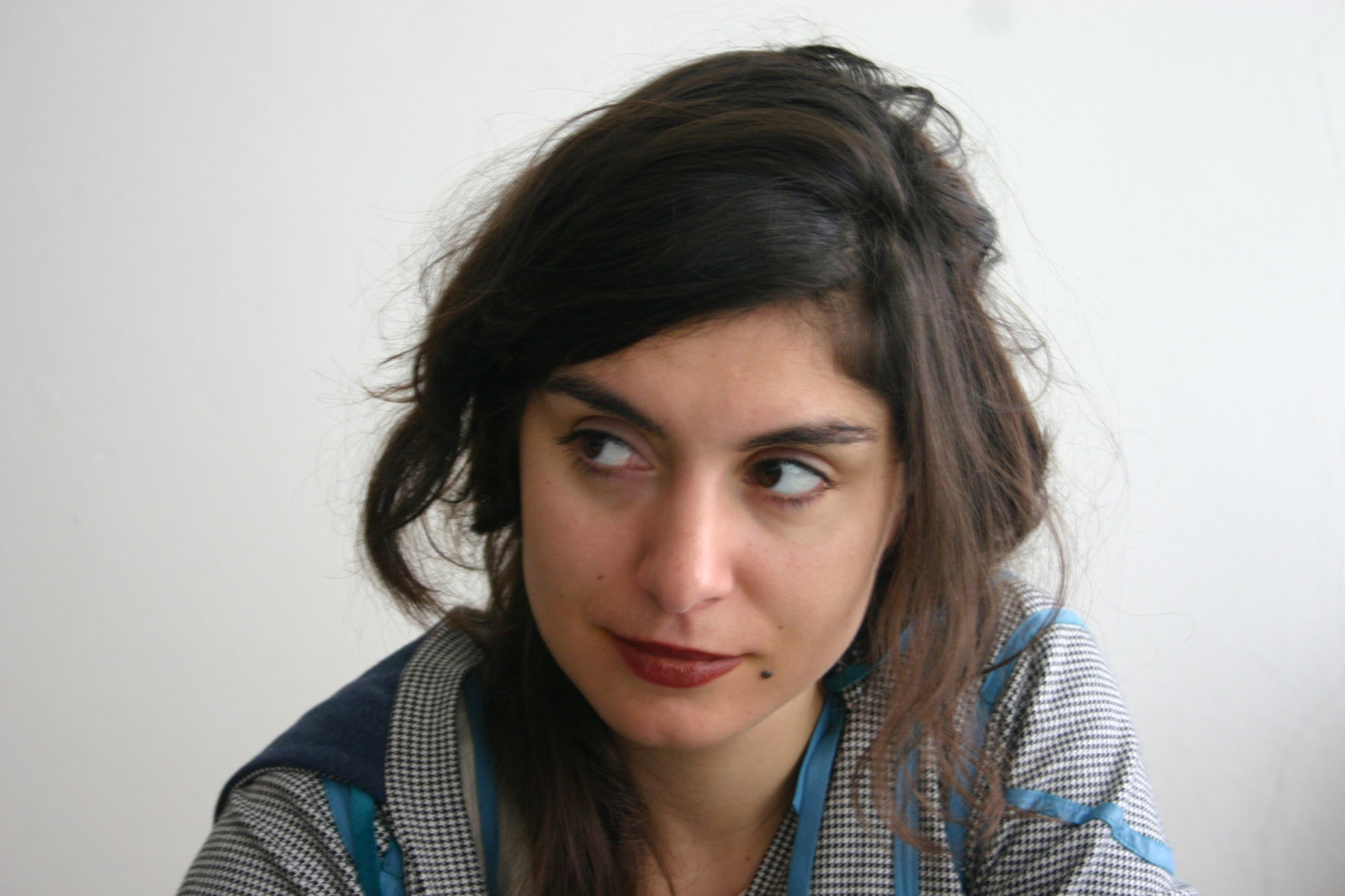
| Photo © Sara Masüger | |
|
Rosa Barba was born in 1972 in Agrigento, Italy. She currently lives and works in Berlin. Barba studied at the Academy of Media Arts Cologne and has completed her PhD at the Malmö Faculty of Fine and Performing Arts, Lund University in 2018. She has been a visiting professor at MIT, ACT (Program in Art, Culture and Technology), in Cambridge, Massachusetts. Barba holds a professorship in Fine Arts at the University of the Arts, Bremen. Rosa Barba engages with the medium of film through a sculptural approach. In her works, Barba creates installations and site-specific interventions to analyze the ways film articulates space, placing the work and the viewer in a new relationship. Questions of composition, physicality of form and plasticity play an important role for the artist as Barba examines the industry of cinema and its staging vis-à-vis gesture, genre, information and documents. Her film works are situated between experimental documentary and fictional narrative. They often focus on natural landscapes and human-made interventions into the environment and explore the relationship of historical records, personal anecdotes, and filmic representation, creating spaces of memory and uncertainty. More information on the artist and a comprehensive overview of recent institutional exhibitions can be found on our website.
|
|
|
Isa Melsheimer — false ruins and lost innocence
|
|

| Exhibition view: Isa Melsheimer, false ruins and lost innocence, Esther Schipper, Berlin, 2020
Photo © Andrea Rossetti | |
|
Since you cannot be my bride, surely you at least be my tree
In a recent discussion on the landscapes of the 19th century French painter Camille Pissarro, the art historian T.J. Clark notes: "Nature doesn’t have high points is one way of saying it. It is not picturesque. Or rather, [and here he is speaking about a specific painting] the incidents and episodes it does possess ... must cede to the overcast, the overall, the non-ominous totality.”
His text reminded me of a photo I once took in a forest. I thought the perfectly aligned tree trunks recalled the World War II military cemeteries in Normandy with their gridded white tombstones that create dynamic linear pattern across the green lawns. Lining up in every direction, the effect is both depersonalizing and awe-inspiring. The picture I shot, suffice to say, looked nothing like that. I could not even discern the simple pattern that had seemed so compelling to my eyes in the photograph.
Landscapes then are made. The point of Clark's essay is to trace Pissarro’s ability to capture an atmosphere of ordinariness and evenness without tipping toward the indistinct or indecisive as my photograph did. It is a kind of “refusal of emphasis” which Clark also calls as “the difference between scene and scenery.”
|
|
|

| Exhibition view: Isa Melsheimer, false ruins and lost innocence, Esther Schipper, Berlin, 2020
Photo © Andrea Rossetti | |
|
Isa Melsheimer has said that she sees nature encroaching into urban landscapes and human interventions into natural processes. The topiary tree she placed just inside her exhibition exemplifies this entanglement and the near impossibility of returning (and even imagining) an originary state in which nature is not given a shape through human eyes. The bulbous heads of firs may grow out their cropped shape, but the tree cannot shed its human-made form altogether.
Melsheimer’s new large-scale ceramics construct scenarios of equivalence, literally fusing its contradictory elements in structurally and conceptually complex works. As Melsheimer noted Corbusier would have been appalled by the horse’s head in his villa. Yet, with fine irreverence her ceramic drawing on the architect’s mid-20th century Villa Shodhan in Ahmedabad makes this combination seem quite plausible, even.
As the artist tells it, a source of her new series of ceramics lies in the sculptures of human figures fused with plants or rocks she noticed walking in the gardens of the Neue Palais, in Potsdam’s Sanssouci, the 18th century park built under Frederick II. In the series’ (and exhibition’s) title, false ruins and lost innocence, taken from Charles Jencks’ critique of postmodern whimsy, those fantastic grottoes and false ruins of the 18th century resonate. In those carefully constructed gardens—wild in the anglophile, geometric in the francophile world—hybrid beings congregated in structures built to evoke fantastic lost worlds.
|
|
|
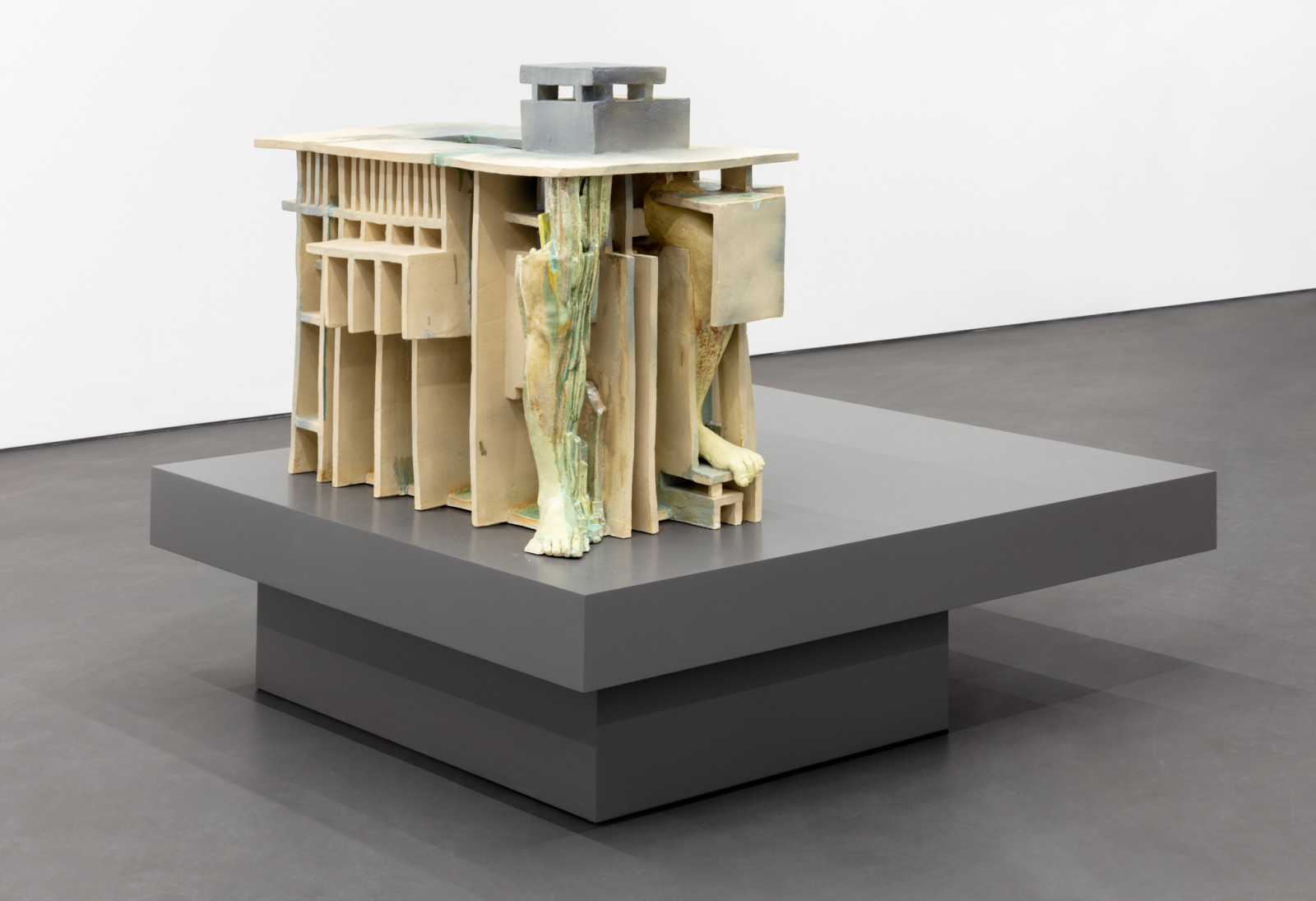
| Isa Melsheimer, false ruins and lost innocence 1, 2020, ceramics, plinth, 104 x 80,5 x 122 cm (work), 50 x 160 x 110 cm (plinth)
Photo © Andrea Rossetti | |
|
The hybridity of form in Melsheimer’s practice always has larger connotations. Take for example the myth of Daphne: the nymph was pursued by an amorous god and in desperation wished to be transformed in order to “destroy the beauty which makes me please too well” as Ovid tells the story. Still, this did not protect her from her pursuer’s advances: “Even as a tree, Phoebus loved her. He placed his hand against the trunk, and felt her heart still beating under the new bark. Embracing the branches as if they were limbs, he kissed the wood: but, even as a tree, she shrank from his kisses. Then the god said: ‘Since you cannot be my bride, surely you at least be my tree.’”
Reading this today it is difficult not to shudder and consider the violence of these famous classical tales of mythic pursuit, evasion, and conquest in broader terms. Melsheimer’s new ceramics do this with a light touch: adding to her long preoccupation with the layered meanings of architectural structures, the inherent power struggle between nature and culture shines through with bright irreverence.
—Isabelle Moffat
|
|
|
On Saturday December 12, Isa Melsheimer toured her exhibition false ruins and lost innocence with author, musician, and curator Jan Kage. Jan Kage has published books and records and curated exhibitions in Germany and abroad. His broadcast Radio Arty has aired weekly on FluxFM since 2009. Since 2010 he is the director of Kunstraum Schau Fenster and since 2018 of the Galerie Kanya&Kage in Berlin. Watch their lively and informative exchange HERE!
|
|
|
Hito Steyerl — Virtual Leonardo’s Submarine and K21
|
|

| Hito Steyerl, Virtual Leonardo’s Submarine, 2020, Virtual Reality, duration variable
© VG Bild-Kunst, Bonn, 2020. Visual © Hito Steyerl | |
|
Virtual Leonardo’s Submarine is Hito Steyerl’s first solo project with Esther Schipper and the first virtual exhibition organized by the gallery. This project is organized in collaboration with Andrew Kreps Gallery, New York.
Originally conceived in 2019 as a video environment for the 58th Venice Biennale, Leonardo’s Submarine has been completely reworked as a Virtual Reality (VR) experience. Upon entering the virtual space—via the means of a VR headset or by web browser version—viewers will find themselves floating under water, surrounded by fish, seaweed, and coral. The artist’s avatar, outfitted in full PEOPLE gear, swims alongside.
|
|
|
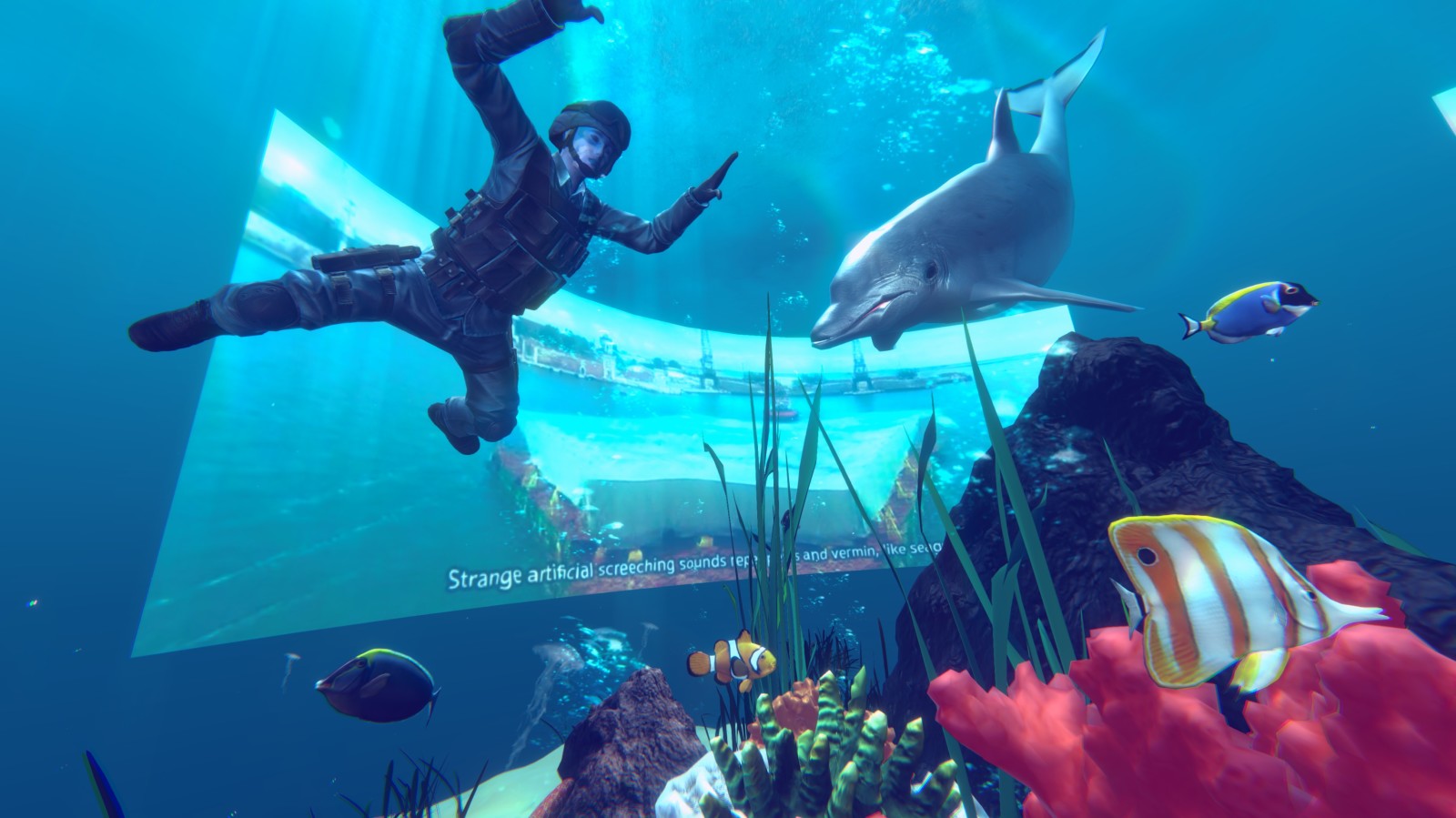
| Hito Steyerl, Virtual Leonardo’s Submarine, 2020, Virtual Reality, duration variable
© VG Bild-Kunst, Bonn, 2020. Image © Hito Steyerl | |
|
The VR experience offered by Virtual Leonardo’s Submarine echoes Steyerl’s concept of a Bubble Vision which she developed during her 2018 lecture at the Yale School of Art. VR experiences place the viewer at the center of an environment while also disembodying them: “The viewer is absolutely central, but at the same time, he or she is missing from the scene. (…) Is this ‘bubble vision’—this 360-degree vision—a training scheme to adapt humans to a world from which they are increasingly missing because they have been replaced by invisible systems or automation or robot?” asks Steyerl. Hito Steyerl's lecture Bubble Vision at Penny Stamps School of Art & Design at the University of Michigan can be viewed on our website, HERE.
|
|
|

| A selection of texts, podcasts, lectures and digital works on the website of K21, Kunstsammlung Nordrhein-Westfalen. © VG Bild-Kunst, Bonn, 2020
Images © Hito Steyerl
Visual © K+ Digital Guide, Kunstsammlung Nordrhein Westfalen, 2020
| |
|
While I Will Survive, Hito Steyerl major exhibition at K21 in Düsseldorf, is currently closed, the museum's website features extensive additional material to learn more about the artist's work. Here you will find texts, video clips, and a podcast about the exhibition. You can also watch a tour of the exhibition I Will Survive with curator Doris Krystof HERE.I Will Survive presents the first comprehensive exhibition dedicated to the artist, filmmaker, and author Hito Steyerl. Steyerl is currently regarded as one of the most advanced artists in terms of the current reflection on the social role of art and museums, the development of artificial intelligence, and experimentation with media-based forms of presentation. With early works exemplary of the “documentary turn”, the exhibition begins with a different conception of the documentary, the conceptual change of which Steyerl has decisively co-conceived, formulated, and practiced. Another key aspect of Steyerl’s work is the mutations of camera images over the past thirty years, from the development from analog images and their manifold montages to the shared, increasingly fluid image of the digital information age. In her most recent works, Steyerl takes a critical look at how art is increasingly becoming the object of investment and speculation, determined and driven by large galleries and powerful oligarchs. The concept of public art, to which Steyerl lays claim, thus takes on a new meaning. In Spring 2021 the exhibition is scheduled to open at the Centre Pompidou, Musée National d’Art Moderne, Paris, which cooperated with the Kunstsammlung Nordrhein-Westfalen, in Düsseldorf on the exhibition.
|
|
|

| Exhibition view: Hito Steyerl, I Will Survive, K21, Düsseldorf, 2020
© VG Bild-Kunst, Bonn, 2020
Photo © Achim Kukulies, Düsseldorf
| |
|
The video installation SocialSim was made for the exhibition I Will Survive at K21. Due to the current shutdown, Hito Steyerl adapted a part of her video installation, the social simulation Dancing Mania, into virtual space. Social simulations are models used by behavioral scientists. Through different parameters, so-called quantified social interactions, prognoses of energy consumption, riots, suicide rates, and rates of infection are made. |
|
|

| Hito Steyerl, Dancing Mania, XR version, 2020, on the website of the Kunstsammlung Nordrhein-Westfalen
© VG Bild-Kunst, Bonn, 2020
Image © Hito Steyerl
| |
|
Dancing Mania is a simulation, in which an infection from an unknown source as well as its spread is simulated. We do not know, whether the pathogen is an illness, maniac dancing, information overdose or conspiracy theories, however, the mathematics stay the same. Dancing Mania shows the parameters behind the graphics, which influence the everyday life of many people worldwide. The simulation also shows, that through a change of parameters, the spread of let's say conspiracy theories can be stopped. Apart from that, the simulation offers a convincing alternative to Cyberpunk 2077, even though the size of the genitals is not changeable. The immersive VR view allows the player to be in the middle of the event. Perfect for the lockdown and the Advent season.
Further information on navigation and hardware recommendations can be found on the site linked to the above image.
|
|
|
Daniel Steegmann Mangrané — TBA21, Madrid and online at st_age
|
|
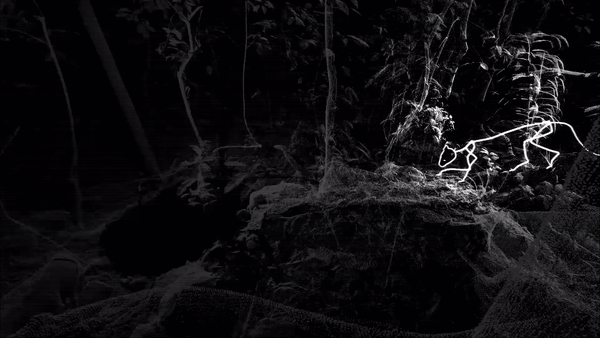
| Daniel Steegmann Mangrané, A Dream Dreaming a Dream, 2020, video projection (real-time procedural computer-generated animation, black and white), 4-channel sound
Visual © Daniel Steegmann Mangrané | |
|
Daniel Steegmann Mangrané’s new work A Dream Dreaming a Dream is a procedural computer animation that is continuously changing in real time. The project is currently on view in Madrid but has an independent digital presence and a wealth of additional materials available online which we introduce below.
How to Tread Lightly. st_age expanded, an exhibition reframes the challenges raised by the Covid-19 crisis in terms of supporting artistic practice. The exhibition, curated by Soledad Gutiérrez, is a physical-world extension of the artists’ projects currently being presented during Season 1 of st_age, an online commissions initiative launched in September 2020 by Thyssen-Bornemisza Art Contemporary (TBA21). |
|
|

| Daniel Steegmann Mangrané, A Dream Dreaming a Dream, 2020, video projection (real-time procedural computer-generated animation, black and white), 4-channel sound
Exhibition view: How to Tread Lightly, Thyssen-Bornemisza National Museum, Madrid, 2020
Photo © Roberto Ruiz | |
|
Daniel Steegmann Mangrané’s A Dream Dreaming a Dream is infinitely self-generating and continuously changes in real time. Drawing on the artists 3D virtual environment Phantom (Kingdom of all the animals and all the beasts is my name), the work places an animated figure of a panther inside a digital space in a continuous animation.
The digital representation of the 3D-scanned rain forest is the basis of the work in which the computer-generated representation of the panther is presented. The rainforest's densely leafed underbrush, delicate foliage and branches, as well as its floor covered with leaves and ferns are delineated by small white dots, while the panther is depicted by gently glowing short graphic lines that articulate his form and limbs. The simplified representation is surprisingly life-like and even transports a certain soulfulness that evokes the dream state of the work’s title.
The presence of the panther in A Dream Dreaming a Dream illuminates its immediate surroundings. Where the animal is, the landscape is softly lit and visible in more detail. (This effect is perhaps comparable to the experience of human observers of Phantom’s virtual environment who perceive their immediate vicinity most clearly.)
|
|
|
The panther’s actions in the space—changing sequences of behavior of wandering in the rain forest, sleeping, dreaming, and waking—are determined by a program with a randomness-generating algorithm in real time, that is, the actions of the animal are not predetermined but develop as we watch.
A Dream Dreaming a Dream is inspired by a long-standing theme in Daniel Steegmann Mangrané’s practice: the indigenous perceptions of the forest and understanding of the entities that inhabit it beyond the human as divine characters: from animals, to rivers, to plants, to master spirits or specters. |
|
|

| Click here to view an overview of the available material, including conversation, podcast, videos and the work on the digital platform st_age x KHOJ.
| |
|
There is a wealth of information to be found as part of Daniel Steegmann Mangrané’s project on st_age: an extensive conversation with curator Soledad Gutiérrez, in which Daniel talks about his long interest in the Mata Atlântica region and its inhabitants, and the works it has inspired; a fascinating reading list assembled by the artist with linked pdfs of the texts; a podcast entitled The Dreaming Forest conducted by Helena Palmquist, and a Call to Action by APIB (Articulation of Indigenous Peoples of Brazil), the widest grouping of indigenous peoples in Brazil that is a network of organizations with representation in all regions of the country.
Make sure to click “show research cluster” to view the comprehensive reading list and pdfs of texts the artist has assembled. These documents and resources include recently produced extensive reports addressing the complicity of global investors and multinational companies in the destruction of the Amazon rainforest, as well as articles on the ongoing impact of Covid-19 on indigenous peoples. Press links reveal the horrors of the Bolsonaro administration’s dismantling of environmental and indigenous protections, and anthropological texts address the Amerindian preoccupation with inhabiting the points of view of nonhuman selves.
|
|
|
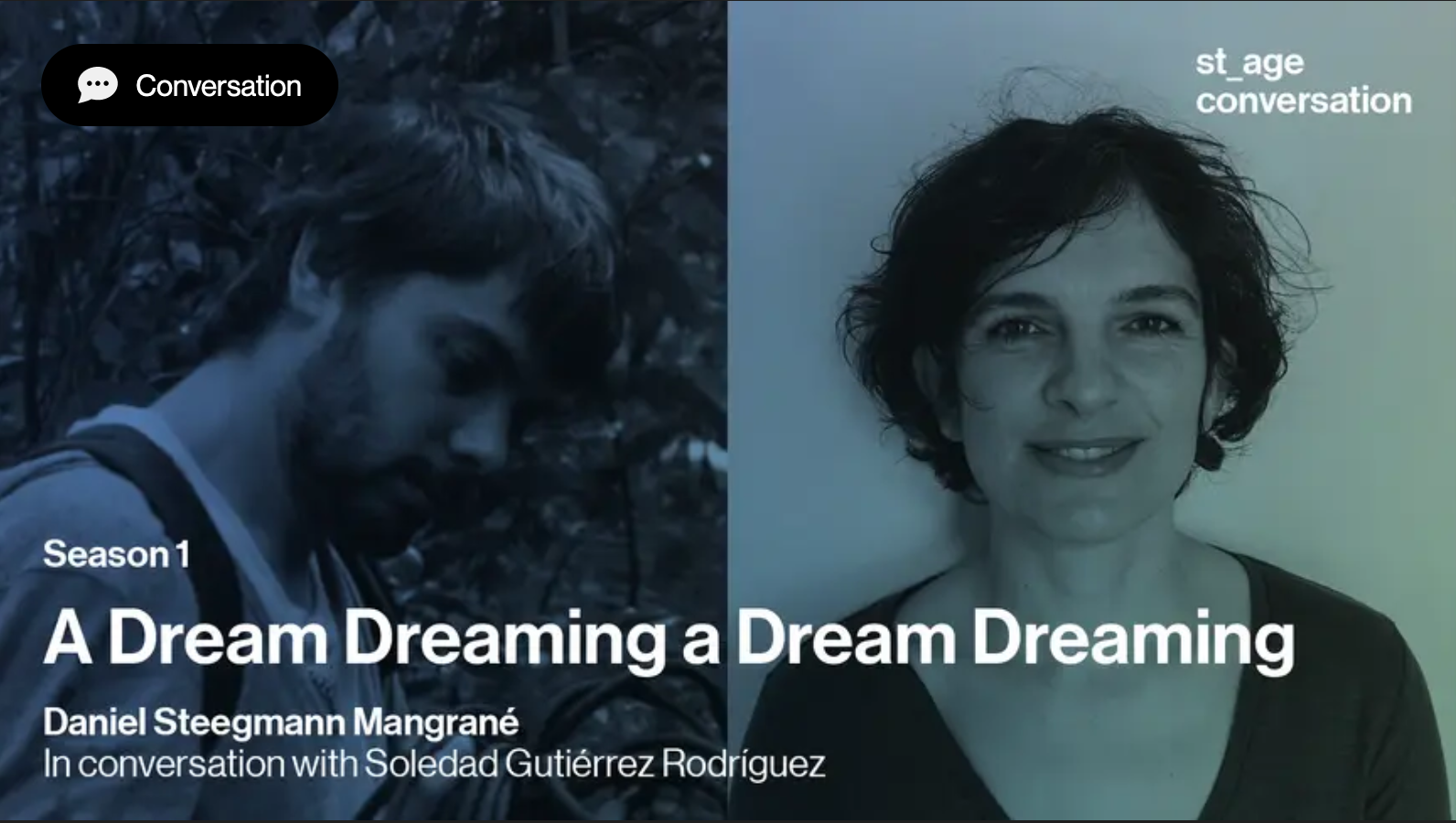
| Click here to watch the interview | |
|
Departing from Daniel Steegmann Mangrané’s animation on st_age, this conversation with the artist explores his long term interest in Amazonian ecology and how it has led to a deeper understanding of the Ameridian perspectives in his practice. Steegmann unpacks some of the questions raised in his Episode’s st_age podcast, and describes his connection with APIB (Articulation of Indigenous Peoples of Brazil) the organization of the Call for Action. |
|
|
Jean-Pascal Flavien — How to Survive, Sprengel 360°
|
|

| Jean-Pascal Flavien, Description of a Struggle, 2020, wood, drywall, rebars, plastic mesh, 3,85 x 9,9 x 4,5 m. Produced by Sprengel Museum Hannover with the support of Gartenheim eG 2020.
Exhibition view: How to Survive. Art as a Survival Strategy, Sprengel Museum, Hannover, 2020
Photo © studioflavien | |
|
Jean-Pascal Flavien’s project for How To Survive. Art as a Survival Strategy, at the Sprengel Museum in Hannover originated as analog exhibition—and the work is in fact installed—yet also has a digital presence as part of a virtual tour you can take on the museum’s website, Sprengel 360°.
With his new house, entitled Description of a Struggle, Flavien encapsulated the subject of the exhibition, even more eerily poignant this year than in others. Drawing on his early models for landscape house, which manifested as abstract embodiments of catastrophic states, this structure simultaneously represents freedom and constraint: the house with its seven enclosed spaces leaves it to the inhabitants to make it their own.
As the artist has put it:
Description of a Struggle is the title of a short story by Franz Kafka. I wanted to redo this description in another form. Let the house become a description. A habitable object that wants to be a text. Is it a dream? The description would assemble the elements of a conjecture—walls, passages, rooms—and would define the contours. To describe would be to produce a situation by giving it terms. Describe a life by giving it a daily outline.
The exterior walls encloses seven spaces divided by roughly finished plaster partitions. Beyond the white wall preventing entry, the seven rooms are doorless and do not communicate. The house is in a state of sleep, waiting for its inhabitant. The resident will have to make an effort to inhabit this place: going through the walls, perforating surfaces, making one's way. They may settle in the first room while leaving the other walls untouched, nestle, lie down, give up, or dig further into the house, to the right or the left, continue, decide on another action. The choices that arise are made of stops, bifurcations, and destruction. A struggle! I imagine something animal-like and feral in this everyday. Living is drawing a line through the spaces, like tracing a tunnel in a mine.
Usually architecture decides on a course of action, on what it separates, what it brings together, even in the intimacy that it sometimes invents and fosters. To live in it, by dint of repetitions, of adjustments, forces one to shape one's life to the form of this space, inducing similar convergences in your habits, assimilating comparable distancings in once’s thoughts. There seems to be a contradiction in this house which is in appearance more constraining, but by not deciding the openings, and the layout of the flows, it leaves the inhabitant the choice of making a route, even if with a destructive gesture. I would like the house to withdraw from determination, to impose almost nothing, that life is not written there. |
|
|
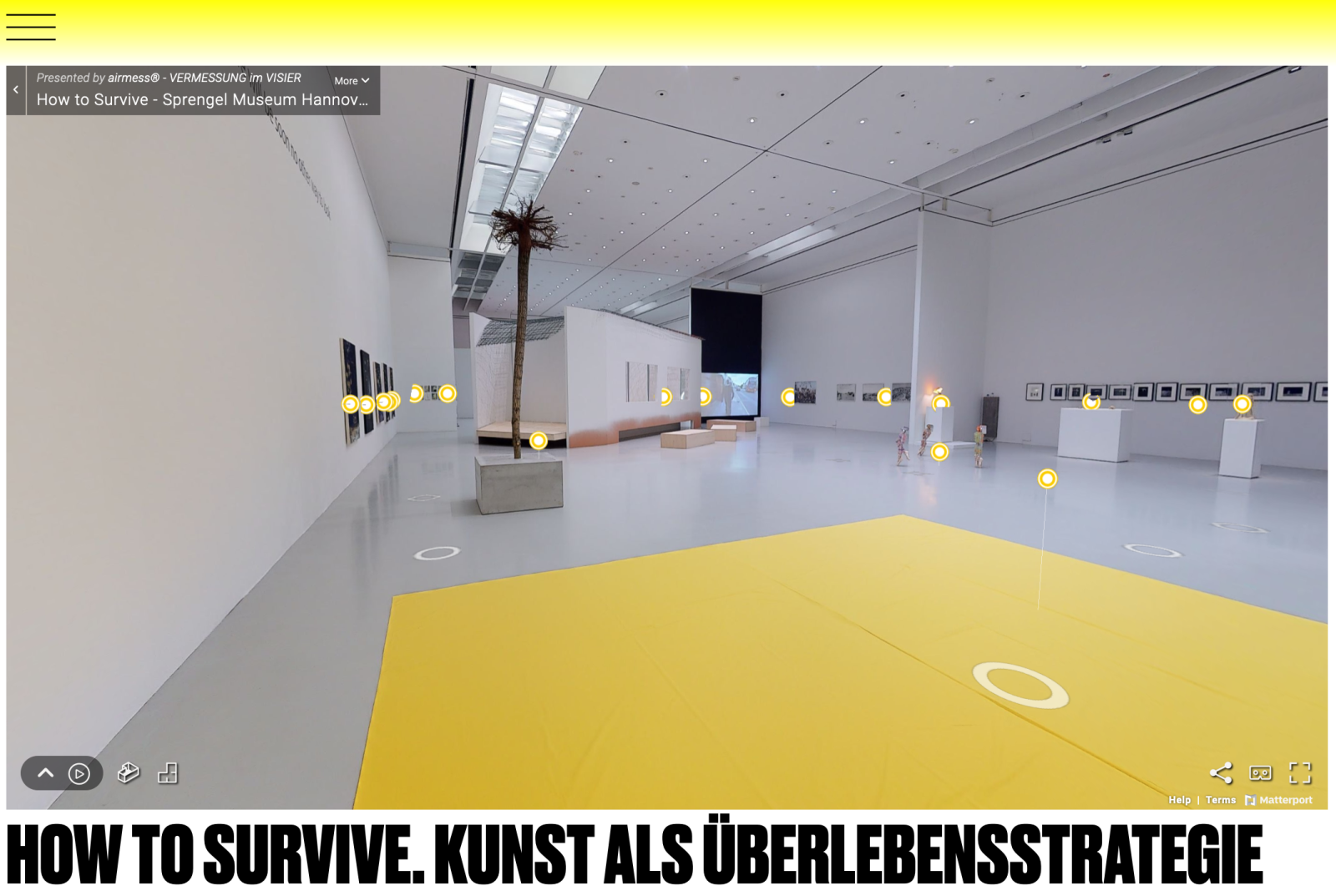
| Screen shot, How to Survive. Art as a Survival Strategy, Sprengel 360° virtual exhibition tour with navigation panels in left and right corner.
| |
|
How to Survive. Art as a Survival Strategy, is accessible via the Sprengel 360° virtual tour. The exhibition combines artistic approaches from the 1960s to the present day that have dealt with both individual and global crises and whose questions and solutions survive in their works. The exhibition features the work of 14 artists, including Jean-Pascal Flavien, whose new house Description of a Struggle has been conceived and built for the occasion. The exhibition is being extended through April 2021 and will open to the public after restrictions are lifted. Sprengel 360° takes visitors on a tour through the entire exhibition, yet also gives the opportunity to navigate independently to view individual works in more detail.
|
|
|
Angela Bulloch, Isa Melsheimer & Christopher Roth – Fahrbereitschaft |
|
Mein Vater, meine Nachbarn, meine Freunde, und deren Freunde with Angela Bulloch, Isa Melsheimer & Christopher Rothhaubrok foundation, Fahrbereitschaft, Berlin The exhibition is closed until further notice www.tremsal.deZoom Conversation with the Participating ArtistsSaturday December 19, 2020, 4 pm Watch the talk live on www.tremsal.de and www.space-time.tv
|
|
|
Esther Schipper Online — Online Viewing Rooms
|
|
OVR: Miami Beach
Online Viewing Room
Through January 9, 2021
Online Now
Exhibition view: OVR: Miami Beach, Esther Schipper, Berlin, 2020
Photo © Andrea Rossetti |
|
|
Daata Fair Miami
A solo presentation by David Claerbout
Online Only Art Fair
Through January 9, 2021
Online Now
David Claerbout, Wildfire (meditation on fire), 2019-2020, single channel video projection, 3D animation (stereo audio, color), duration: 24 min
© VG Bild-Kunst, Bonn, 2020
Film still © David Claerbout |
|
|
The Reading Corner – Esther Schipper Bookstore
|
|
To celebrate the holiday season, the Esther Schipper Bookstore presents works, limited editions, multiples, rare publications, and new monographs! Browse the Esther Schipper Bookstore Brochure to see more available items at our bookstore in Berlin and online. Please also note that all orders received at this point will be sent out in January 2021.
|
|
|
|
|